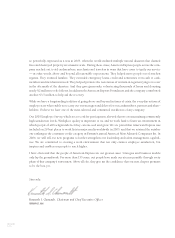American Express 2005 Annual Report Download - page 29
Download and view the complete annual report
Please find page 29 of the 2005 American Express annual report below. You can navigate through the pages in the report by either clicking on the pages listed below, or by using the keyword search tool below to find specific information within the annual report.
Critical Accounting Policies
The Company’s significant accounting policies are described in Note 1 to the Consolidated Financial Statements. The following
provides information about critical accounting policies that are important to the Consolidated Financial Statements and that
require significant management assumptions and judgments about the effect of matters that are uncertain. These policies relate
to reserves for cardmember losses, reserve for Membership Rewards costs and asset securitizations.
Reserves for cardmember losses
Critical Accounting Policies Assumptions/Approach Used Effect if Actual Results Differ
from Assumptions
Reserves for losses relating to
cardmember loans and receivables
represent management’s estimate
of the amount necessary to absorb
losses inherent in the Company’s
outstanding portfolio of loans
and receivables.
Reserves for these losses are
primarily based upon models that
analyze several specific portfolio
statistics, including average
write-off rates for various stages
of receivable aging (i.e., current,
30 days, 60 days, 90 days) over a
24-month period and average
bankruptcy and recovery rates.
Also, to a lesser extent, these
reserves reflect management’s
judgment regarding overall
adequacy. In exercising its
judgment to adjust reserves that
are calculated by the analytic
model, management considers
emerging trends and the level of
coverage of past-due accounts, as
well as external indicators, such
as leading economic indicators,
unemployment rate, consumer
confidence index, purchasing
manager’s index, bankruptcy
filings and the legal and
regulatory environment.
To the extent historical credit
experience is not indicative of
future performance or other
assumptions used by management
do not prevail, loss experience
could differ significantly, resulting
in either higher or lower future
provisions for losses, as applicable.
As of December 31, 2005, a 20
basis point change in the average
write-off rate on cardmember loans
and receivables balances would
change the reserve for losses by
approximately $140 million.
Financial Review
AXP / AR.2005
[27 ]
























